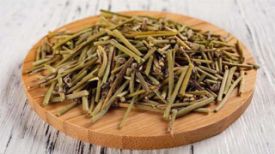Drug name: Qianghuo
Nickname: Silkworm Qiang, Qu Yao
Source: "This Classic"
Classification: Antitumor drugs
Origin: Shaanxi, Sichuan, Gansu and other regions
Taste: Warm in nature, spicy and bitter in taste
Meridian return: return to the bladder and kidney meridians
Effect: Relieve external cold, relieve pain, dispel wind and overcome dampness
Indications: External wind cold, strong headache, wind cold dampness Bi, shoulder and back pain
Characteristic identification of Qianghuo: It is a cylindrical slightly curved rhizome, with a length of 4-13cm and a diameter of 0.6-2.5cm. The top has stem marks, with a surface brownish to dark brown, and the shedding of the outer skin appears yellow. The internodes shorten and form a tightly raised circular shape, resembling a silkworm (commonly known as the silkworm Qiang); Or the internodes are elongated, shaped like bamboo nodes (commonly known as bamboo joint Qiang). There are many dotted or nodular root marks and brown fragmented scales on the nodes, which are light, brittle, and easy to break. The cross-section is uneven with many cracks, and the skin is yellow brown to dark brown, oily with brown oil spots. The wood is yellow white with obvious rays, and the pulp is yellow to yellow brown. It has a fragrant and slightly bitter taste.
Usage&Taboos
Internal administration: decoction, 3-10g; Or into pills or powder.
Taboos:
Patients with chronic hepatitis, chronic gastritis, chronic illness, weak spleen and stomach, and loss of appetite should avoid taking large amounts of it for a long time; Pregnant women should not take it for a long time
Chemical composition: This product contains volatile oil, β - sitosterol, coumarin compounds, phenolic compounds, carotenoids, apigenin B, organic acids, and alkaloids.
pharmacological action
1. Antibacterial effect: It has an inhibitory effect on Brucella and skin fungi.
2. Anti shock effect: The decoction can significantly reduce the number of mice that produce shock reactions or die from shock.
3. Antipyretic and analgesic effects: The volatile oil of Qianghuo can stimulate sweat glands and relieve fever, and significantly reduce the number of body twists in mice, showing a significant analgesic effect.
Chinese herbal formula 1: Treatment of sun typhoid fever without sweating: Qianghuo, Duhuo, Jingjie, Fangfeng, Guangpi, Licorice, decocted and taken. (Medical Grade Qianghuo Tang) 2. Symptoms of cold invasion of the brain, brain pain and toothache, cold hands and feet, cold mouth and nose qi: Qianghuo one coin, five cents each of aconite and ginger, eight cents each of roasted licorice, decoction in water. 3. Treatment of rheumatism, body pain and discomfort, inability to bend or extend due to pain, or slight swelling and inhumanity: Qianghuo (removing reeds), Fuzi (processing, removing skin and navel), Atractylodes macrocephala, licorice (roasting), etc. Take four coins per serving, one and a half cups of water, five slices of ginger, pan fry until seven cents, remove any impurities, and warm up at any time. ("Ji Sheng Fang" Qiang Fu Tang)
According to the ancient book "Tang Bencao", Du Huo is suitable for treating wind, and Qiang Huo is suitable for treating water. "The Treatise on Medicinal Properties": To treat thief's wind, silent and silent, often itchy and bloody, unable to move hands and feet, with evil in the mouth and face, and stubborn numbness throughout the body. The Encounter of the Original Classic: Qiang Huo is the commander-in-chief of chaos and disorder, with wind energy surpassing dampness. Therefore, Qiang Huo can treat water and dampness, and is used together with Xiong Qiong to treat headaches in the sun and jue yin, dispel sweating and dispel external heat, penetrate the meridians and promote diuresis. It is not an elixir for colds at all times. In the past, people used to treat labor induced coldness in the Bu Zhong Yi Qi Tang, which deeply understood the meaning of Bu Zhong implying diarrhea.
Traditional Chinese Medicine - Qianghuo
Release time:2024-06-03 17:28:13
Reading:206
Word Count:3955
Subscribe to email


